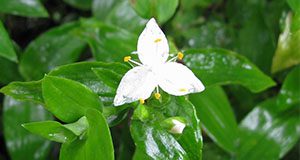Tradescantia fluminensis (small-leaf spiderwort) is a perennial subsucculent herb native to tropical and subtropical regions of Brazil and Argentina. The species has been introduced to the United States and countries in many parts of the world where it is often considered invasive. This seven-page fact sheet describes the small-leaf spiderwort, its taxonomy, geographical distribution, biology and ecology, reproduction and colonization, its impact as a weed in the southeastern United States, and ways of managing the spread of small-leaf spiderwort. Written by Jason C. Setiz and Mark W. Clark and published by the Department of Soil and Water Science.
http://edis.ifas.ufl.edu/ss652
Tag: Biological Control of Weeds
Allelopathy: How Plants Suppress Other Plants (HS944/HS186)
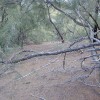 Allelopathy refers to the beneficial or harmful effects of one plant on another plant, both crop and weed species, from the release of biochemicals, known as allelochemicals, from plant parts by leaching, root exudation, volatilization, residue decomposition, and other processes in both natural and agricultural systems. This 5-page fact sheet introduces the concept of allelopathy and mentions potential applications as an alternative weed management strategy. Written by James J. Ferguson, Bala Rathinasabapathi, and Carlene A. Chase, and published by the UF Department of Horticultural Sciences, March 2013.
Allelopathy refers to the beneficial or harmful effects of one plant on another plant, both crop and weed species, from the release of biochemicals, known as allelochemicals, from plant parts by leaching, root exudation, volatilization, residue decomposition, and other processes in both natural and agricultural systems. This 5-page fact sheet introduces the concept of allelopathy and mentions potential applications as an alternative weed management strategy. Written by James J. Ferguson, Bala Rathinasabapathi, and Carlene A. Chase, and published by the UF Department of Horticultural Sciences, March 2013.
http://edis.ifas.ufl.edu/hs186
Florida's Established Arthropod Weed Biological Control Agents and Their Targets (ENY853/IN779)
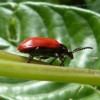 Around 5% of the plant species deliberately introduced into Florida for crop production and horticultural uses have invaded sensitive aquatic and terrestrial natural areas as well as improved pastures. One of the reasons they become invasive is they lack the natural enemies that limit their reproduction. Biological control reunites these natural enemies (usually arthropods) with their host plants to selectively weaken and suppress the invasive weeds. This 3-page fact sheet was written by J. P. Cuda and J. H. Frank, and published by the UF Department of Entomology and Nematology, October 2013.
Around 5% of the plant species deliberately introduced into Florida for crop production and horticultural uses have invaded sensitive aquatic and terrestrial natural areas as well as improved pastures. One of the reasons they become invasive is they lack the natural enemies that limit their reproduction. Biological control reunites these natural enemies (usually arthropods) with their host plants to selectively weaken and suppress the invasive weeds. This 3-page fact sheet was written by J. P. Cuda and J. H. Frank, and published by the UF Department of Entomology and Nematology, October 2013.
http://edis.ifas.ufl.edu/in779
Grass Carp: A Fish for Biological Management of Hydrilla and Other Aquatic Weeds in Florida (BUL867/FA043)
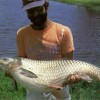 Abundant growth of aquatic plants causes serious problems in ponds, lakes, rivers, and irrigation and drainage throughout Florida. In some situations, native aquatic plants become weeds, but most often exotic plants introduced from areas outside the state flourish under the favorable growing conditions found in Florida. Long-term economical solutions to Florida’s aquatic weed problems have been elusive and there is a need for control techniques to alleviate aquatic weed problems. This 6-page fact sheet provides information on a biological method, the grass carp, for management of some of Florida’s aquatic weed problems. Written by David L. Sutton and Vernon V. Vandiver, Jr., and published by the UF Department of Fisheries and Aquatic Sciences, November 2013.
Abundant growth of aquatic plants causes serious problems in ponds, lakes, rivers, and irrigation and drainage throughout Florida. In some situations, native aquatic plants become weeds, but most often exotic plants introduced from areas outside the state flourish under the favorable growing conditions found in Florida. Long-term economical solutions to Florida’s aquatic weed problems have been elusive and there is a need for control techniques to alleviate aquatic weed problems. This 6-page fact sheet provides information on a biological method, the grass carp, for management of some of Florida’s aquatic weed problems. Written by David L. Sutton and Vernon V. Vandiver, Jr., and published by the UF Department of Fisheries and Aquatic Sciences, November 2013.
http://edis.ifas.ufl.edu/fa043
Tropical Soda Apple Leaf Beetle, Gratiana boliviana Spaeth (Insecta: Coleoptera: Chrysomelidae: Cassidinae) (EENY543/IN974)
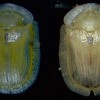 Tropical soda apple is a prickly shrub native to South America that is a major problem in pastures and conservation areas. So a multi-agency program supported the rearing, distribution, and release of more than 250,000 tropical soda apple leaf beetles across Florida from 2003 to 2011. This 4-page fact sheet was written by Rodrigo Diaz, William A. Overholt, Ken Hibbard, and Julio Medal, and published by the UF Department of Entomology and Nematology, January 2013.
Tropical soda apple is a prickly shrub native to South America that is a major problem in pastures and conservation areas. So a multi-agency program supported the rearing, distribution, and release of more than 250,000 tropical soda apple leaf beetles across Florida from 2003 to 2011. This 4-page fact sheet was written by Rodrigo Diaz, William A. Overholt, Ken Hibbard, and Julio Medal, and published by the UF Department of Entomology and Nematology, January 2013.
http://edis.ifas.ufl.edu/in974
Air Potato Leaf Beetle (Suggested Common Name), Lilioceris cheni Gressitt and Kimoto (Insecta: Coleoptera: Chrysomelidae: Criocerinae) (EENY547/IN972)
 This leaf feeding beetle was recently introduced into Florida from China for biological control of air potato. This 4-page fact sheet provides information on the distribution, appearance, life cycle, host range and importance of the beetle. Written by Entomology and Nematology, and published by the UF Department of Ted D. Center and William A. Overholt, January 2013.
This leaf feeding beetle was recently introduced into Florida from China for biological control of air potato. This 4-page fact sheet provides information on the distribution, appearance, life cycle, host range and importance of the beetle. Written by Entomology and Nematology, and published by the UF Department of Ted D. Center and William A. Overholt, January 2013.
http://edis.ifas.ufl.edu/in972
ENY853/IN779 Florida’s Established Arthropod Weed Biological Control Agents and Their Targets
ENY853, a 3-page fact sheet by J. P. Cuda and J. H. Frank, describes the role of biological control agents in controlling nonnative invasive weeds, lists the arthropod bilogical control agents that are established for seven invasive weeds, and provides links to additional resources. Includes references. Published by the UF Department of Entomology and Nematology, September 2009.
http://edis.ifas.ufl.edu/IN779
